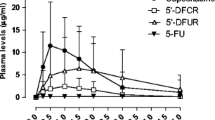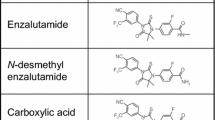Abstract
Purpose: In the present study the possible influence of the antacid Maalox on the pharmacokinetics of capecitabine (Xeloda) and its metabolites was investigated in cancer patients. Methods: A total of 12 patients with solid, predominantly metastatic tumors of various origin received a single oral dose of 1250 mg/m2 of capecitabine (treatment A), a single oral dose of 1250 mg/m2 of capecitabine followed immediately by 20 ml of Maalox (treatment B), and a single oral dose of 1250 mg/m2 of capecitabine followed 2 h later by 20 ml of Maalox (treatment C) in an open, randomized, three-way cross over fashion. Serial blood and urine samples were collected for up to 24 h after each administration. Unchanged capecitabine and its metabolites were analyzed in plasma using liquid chromatography/mass spectrometry and in urine using nuclear magnetic resonance spectroscopy. Results: Administration of Maalox either concomitantly with capecitabine or delayed by 2 h did not influence the time to peak plasma concentrations (Cmax) or the elimination half-lives of capecitabine and its metabolites. Unexpectedly, moderate increases in the Cmax and AUC0–∞ values obtained for capecitabine and 5′-deoxy-5-fluorocytidine were observed when Maalox was given together with capecitabine. However, these increases, which ranged between 10% and 31%, were not statistically significant (P > 0.05) and are not of clinical significance. There was no indication of consistent changes in the plasma concentrations of the other metabolites 5′-deoxy-5′-fluorouridine (5′-DFUR), 5-fluorouracil, and α-fluoro-β-alanine. The Cmax and AUC0–∞ values recorded for these three metabolites increased and decreased in a stochastic manner. The magnitude of these changes was low (<13%) and not statistically significant. The primary statistical analysis of the AUC0–∞obtained for 5′-DFUR provided a P value of 0.4524 and clearly indicated no significant difference between the treatments. The addition of Maalox had no influence on the overall urinary recovery or the proportion of the dose recovered as capecitabine or its metabolites from urine. Conclusion: At the dose used in this study, the effect of concomitantly delivered Maalox on the extent and rate of gastrointestinal absorption of capecitabine is not clinically significant. Therefore, there is no need to adjust the dose or timing of capecitabine administration in patients treated with Maalox.
Similar content being viewed by others
Author information
Authors and Affiliations
Additional information
Received: 11 May 1998 / Accepted: 17 August 1998
Rights and permissions
About this article
Cite this article
Reigner, B., Clive, S., Cassidy, J. et al. Influence of the antacid Maalox on the pharmacokinetics of capecitabine in cancer patients. Cancer Chemother Pharmacol 43, 309–315 (1999). https://doi.org/10.1007/s002800050900
Issue Date:
DOI: https://doi.org/10.1007/s002800050900




